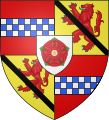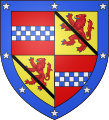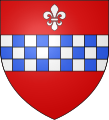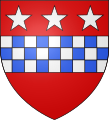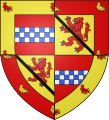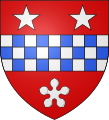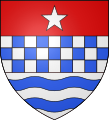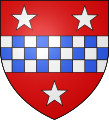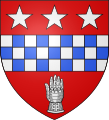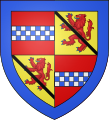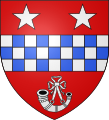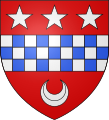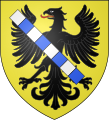Clan Lindsay
| Clan Lindsay | |||
|---|---|---|---|
Seat Balcarres House | | ||
| Historic seat | Crawford Castle Edzell Castle | ||
| |||
| |||
| |||
| |||
Clan Lindsay is a Scottish clan of the Scottish Lowlands.[1]
History

Origins of the clan
The Lindsays were prominent in both England and
In Domesday Book, Sir Baldric de Lindsey of Hemingby is recorded as holding a number of estates in
Sir William Lindsay's elder son was Sir
Wars of Scottish Independence
The aforementioned David Lindsay's grandson was yet another David whose seal was appended to the letter of 1320 to the Pope, asserting the independence of Scotland, that was more often known as the Declaration of Arbroath.[1] His second son, Sir James Lindsay, married Egidia, daughter of Walter Stewart, 6th High Steward of Scotland, and Marjory Bruce, daughter of Robert The Bruce and Isabella de Mar, and half-sister of David II of Scotland, son of Robert the Bruce and his second wife, Elizabeth de Burgh.[1]
14th, 15th and 16th centuries
In 1390, Sir David Lindsay famously took part in a tournament at
The Lindsays fought at the Battle of Arbroath in 1445.[5] In 1452, Alexander Lindsay, 4th Earl of Crawford, joined in a rebellion against James II of Scotland and fought at the Battle of Brechin where the royal forces were victorious.[1] Alexander Lindsay was attained for treason but was later pardoned.[1]
The fifth Earl of Crawford rose high in royal favour.[1] He was successively Lord High Admiral of Scotland, Master of the Royal Household, Lord Chamberlain and High Justiciary.[1] In 1488 he was created Duke of Montrose by King James III, but this was annulled after the king's death. The sixth Earl of Crawford was killed at the Battle of Flodden in 1513,[6] while on close attendance to King James IV.[1]
17th century and civil war
18th century and Jacobite risings
The first Earl of Balcarres was made hereditary governor of Edinburgh Castle.[1] He was also made Secretary of State for Scotland and High Commissioner to the General Assembly.[1] His younger son was Colin Lindsay, 3rd Earl of Balcarres, who was a staunch Jacobite and fought during the Jacobite rising of 1715.[1] He only escaped being attained for treason through the intervention of the Duke of Marlborough who was a lifelong friend of his.[1] In 1739, John Lindsay, 20th Earl of Crawford, was made Lieutenant-Colonel of the newly formed 43rd Regiment of Foot ("Black Watch" regiment) that supported the British Government during the Jacobite rising of 1745 and had been formed from the ten Independent Highland Companies of "Black Watch".[7]
Gallery of arms
-
Traditional Lindsay arms
-
Lindsay, Earls of Crawford
-
Lindsay, Duke of Montrose
-
Lindsay, Earls of Balcarres (1624)
-
Lindsay, Earls of Balcarres (1670)
-
Lindsay of Balcarres
-
Lindsay of Balgawies
-
Lindsay of Barnyards
-
Lindsay of Blacksolme
-
Lindsay of Bonhill
-
Lindsay of Broadland
-
Lindsay of the Byres
-
Lindsay of Cavill
-
Lindsay of Covington
-
Lindsay of Crossbasket
-
Lindsay of Culsh
-
Lindsay of Dowhill
-
Lindsay of Dunrod
-
Lindsay of Eaglescairnie
-
Lindsay of Edzell
-
Lindsay of Evelick
-
Lindsay of Garnock
-
Lindsay of Kilspindie
-
Lindsay of Linbank
-
Lindsay of Loughry
-
Lindsay of Menmuir
-
Lindsay of the Mount
-
Lindsay of Pitscandlie
-
Lindsay of Pitscarlies and Cairn
-
Lindsay of Pyotstone
-
Lindsay of Rossie
-
Lindsay of Spynie
-
Lindsay of Staplegorton
-
Lindsay of Virginia
-
Lindsay of Wauchopedale
-
Lindsay of Wormestone
-
Ancestral arms of Alice de Limési
Clan castles
- John Lindsay of Balcarres in 1595.[8]
- Edzell Castle was the original castle of the Chief of Clan Lindsay which they acquired in 1357 and retained ownership until 1715.[8]
- Crawford Castle, to the north of the village of Crawford, South Lanarkshire, was from where the Earldom of Crawford was created and it was also known as Lindsay Tower.[8]
- Luffness Castle, East Lothian.[8]
- Lamberton Castle, Scottish Borders
- Wauchope Castle, Dumfries and Galloway.[8]
- Carsluith Castle.[8]
- Spynie Palace.[8]
- Lordscairnie Castle.[8]
- Byres Castle, East Lothian.
- Garleton Castle, East Lothian.
- Barnweill Castle, South Ayrshire.
- Craigie Castle, South Ayrshire.
- Lindsane
See also
References
- ^ ISBN 0-00-470547-5.
- ^ "Last name: Lindsay". Surname Database. Retrieved 1 May 2015.
- ^ "Baldric of Lindsey". Open Domesday by Anna Powell-Smith. Retrieved 23 October 2021.
- The Scots Peerage: Founded on Wood's ed. of Sir Robert Douglas's Peerage of Scotland; containing an historical and genealogical account of the nobility of that kingdomby Paul, James Balfour, Sir, 1846–1931
- ^ Arbroath canmore.rcahms.gov.uk. Retrieved 23 July 2013.
- ^ Guthrie, William (1767). A General History of Scotland. Vol. 4. Paternoster Row, London: A. Hamilton, Robinson and Roberts. pp. 371-372. Retrieved 7 May 2023.
- ISBN 0-85976-432-X. pp. 115 – 118.
- ^ ISBN 978-1-899874-36-1.



